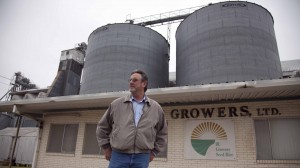How New Water Projects Could Help Both Rice Farmers and the Highland Lakes

Photo by Jeff Heimsath/StateImpact Texas
Joe Crane in front of his rice drying and storgage plant. He expects business to be down drastically this year after water was cut off to rice farmers for the first time in history.
It’s a battle that has gotten ugly at times. Residents, businesses and recreational enthusiasts lament low levels in the Highland Lakes of Travis and Buchanan in Central Texas, as each year massive amounts of water are sent downstream to rice farmers in Southeast Texas. When lake levels go down, business on the lake suffers, home prices drop, and people start to question why we grow rice in Texas in the first place.
And the rice farmers downstream counter that they were here first. The water in the lakes is their water, and they’ll fight to protect it.
Caught in the middle, so to speak, is the Lower Colorado River Authority (LCRA), which manages the lakes and supplies water to Austin (which has its own dog in the fight). With a new plan passed earlier this year that would result in less water going downstream during dry periods, and after cutting off water to rice farmers for the first time in history, the LCRA is under serious pressure to come up with a solution that can placate everyone at the table. Or at least most of them, anyway.
The solution? Building more buckets downstream to catch heavy rains when they do come. And now the LCRA has moved one step closer to that goal.
First, the LCRA is looking to purchase several parcels of agricultural land in Wharton and Colorado counties, where it could build “off-channel” reservoirs from the Colorado River. When excess rains fall, those smaller reservoirs could store the water and save it for rice farmers and others downstream to use.
The LCRA also announced it intends to purchase the Alcoa property northeast of Austin, which “has significant surface water rights and is situated atop a prolific groundwater aquifer.” That property could add as much as 45,000 acre-feet of water a year to the mix, the LCRA says.
The LCRA hopes to gain an additional 100,000 acre-feet of water supply downstream of the Highland Lakes — or 32.5 billion gallons — over the next five years. That would alleviate the strain on the lakes, which neared historic lows last year during a record single-year drought. Despite the exceptionally dry conditions, last year exceptional amounts of water were sent downstream, primarily for rice farmers. More than three times as much as the entire city of Austin used all year.
“These projects could benefit the entire basin for decades to come — from the lakes interests in the upper basin to municipal and industrial water customers to farmers and the river environment,” LCRA Board Chair Tim Timmerman said in a statement.
The LCRA has put down deposits on all the properties while it looks into their feasibility, which could take a year. And it still needs to complete environmental reviews, which will probably take at least six months. But for rice farmers who missed their crop this year, and lake folks who are looking at boat ramps to nowhere, the progress is undeniably welcome.

